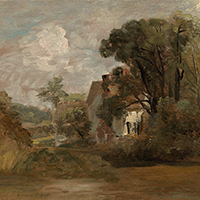Turner and Constable: The Inhabited Landscape
December 15, 2018–March 10, 2019

John Constable
Willy Lott's House
c. 1812–13
Oil on canvas
Clark Art Institute
Gift of the Manton Art Foundation in memory of Sir Edwin and Lady Manton, 2007.8.24
The Built Landscape
The buildings within both Constable’s and Turner’s landscapes not only identify the geography and place landscapes within history, but also reveal each artist’s personal connections to place. The way in which these artists approached the buildings—how they frame them within the view, for example—communicates attitudes and experiences of a place and gives insight into the creative process.
Constable found inspiration in the English countryside, often highlighting small villages, cottages, churches, cathedrals, and other built structures. Born in East Bergholt, Suffolk, Constable delighted in rich, familiar subject material throughout his career, explaining: “Still I should paint my own places best; painting is with me but another word for feeling, and I associate ‘my careless boyhood’ with all that lies on the banks of the Stour; those scenes made me a painter, and I am grateful….”
Turner is represented in this section of the exhibition with three early topographical views that draw upon the picturesque tradition of landscape painting. Human presence within these views broadens their meaning.